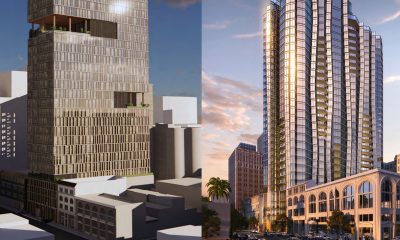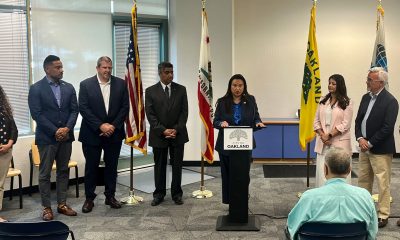Activism
Port Workers and West Oakland Residents Oppose A’s New Ballpark

Over 100 community members attended a discussion held by leaders of the International Longshore and Warehouse Union (ILWU) Local 10 on Sept. 21, to oppose the Oakland Athletics’ plans to build a new ballpark at Howard Terminal.
“This is not about baseball, this is about gobbling up land, this is a real estate investment,” said event organizer and former ILWU Local 10 Secretary-Treasurer Derrick Muhammad as he addressed the crowd gathered at the West Oakland Senior Center.
The A’s proposal to build a stadium at Howard Terminal on the Port of Oakland includes the construction of 3,000 condominiums, a 400 room hotel, and a multi-million dollar gondola to transport fans to and from the park.
ILWU leaders and West Oakland community members expressed concerns about the implications of a ballpark on the city’s industrial waterfront.
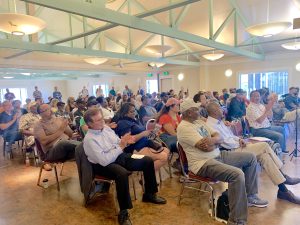
Over 100 community members and port workers gathered at the West Oakland Senior Center to oppose the A’s plans for a new ballpark at Howard Terminal.
“We believe that once you start placing houses adjacent to industry, you subject that industry to complaints of the neighbors,” said Muhammad, who fears that in the long run Oakland could suffer the same fate as Detroit, which some have called a “ghost town” in reference to large swaths of the city that were abandoned after the decline of the automotive industry between 2008 and 2010.
The A’s plan to flank their new ballpark with 3,000 apartments, in the middle of Oakland’s industrial hub where air pollution is some of the highest in the Bay Area. A few hundred yards adjacent to Howard Terminal, recycling plant Schnitzer Steel grinds up and recycles on average over 500,000 metric tons of cars, household appliances and scrap metals per year, according to their 2017-2018 Sustainability Report. While the company has significantly reduced emissions in recent years, during the day acrid smells waft from the plant on to the Howard Terminal lot.
Meanwhile, the A’s are promoting their project as an environmental solution. A Feb. 15 report by the San Francisco Chronicle found that decades of industrial activity had contaminated the soil and groundwater at Howard Terminal with “hazardous” and “cancer-causing chemicals,” that would require removal prior to construction.
On their website, the A’s pledge to “fully remediate these environmental issues at no cost to taxpayers,” along with the rest of the project that they promise will be “100 percent privately financed by the Oakland A’s.”
This statement comes in contrast to a California bill in the works, SB 293, which would potentially allocate millions in public tax money to cover costs for anything from transportation and waste management, to the “remediation of hazardous materials,” on the Howard Terminal property.
If signed by Gov. Newsom, SB 293 will fund the infrastructure needed for the ballpark by creating a new Oakland tax district and will cover any costs related to making the Howard Terminal site buildable and accessible. Major challenges facing the project include sea level mitigation, removal of toxic waste, and transportation infrastructure.
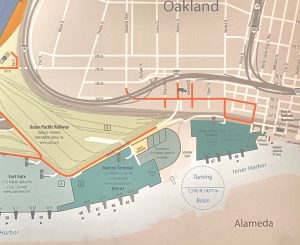
A map depicting the current access points for the Port of Oakland and Howard Terminal.
Aaron Wright, ILWU Local 10 business agent, called the stadium nothing short of a “billionaire’s dream,” and said that the A’s have not taken into account the implications of building on such a challenging site. At the event, he urged community members to “say hell no” to allowing their tax money to subsidize a “billionaire’s condo paradise.”
Howard Terminal is a 50-acre site with a single access point via Market Street. It’s one-third of the size of the Coliseum, which spans 150 acres, and is nearly one mile from the nearest BART station.
Wright also takes issue with Howard Terminal being touted as an “unused” site by project supporters. According to him, the lot serves as an important hub for the hundreds of truckers entering and exiting the port each day, who would otherwise be parking on Oakland streets, clogging the freeways, and increasing pollution in residential West Oakland.
“Howard Terminal actually took that traffic off the streets and gave them a place to stage their loads…it really is a mechanism to keep trucks off the road, to keep trucks out of West Oakland streets,” said Wright.
Due to the spatial restrictions of the lot, the A’s plan to build a substantially smaller parking lot for the stadium, and want to encourage sports fans to leave their cars behind by building a $123 million gondola that would transport up to 6,000 fans per hour per direction from West Oakland BART station to Jack London Square.
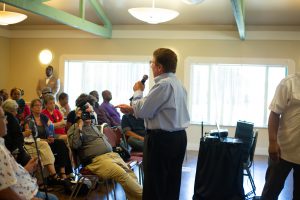
Andrew Garcia, president, and director of marine transportation company GoodBulk Ltd addresses Oaklander at the community meeting on Sept. 21. Photo by Saskia Hatvany.
“The west Oakland community — if that stadium is built — will become the parking lot of the Oakland A’s. There is no way that you will be able to control 20 or 30,000 sports fans coming to a stadium on the waterfront,” said Andrew Garcia, president, and director of marine transportation company GoodBulk Ltd., who also spoke at the event.
Another concern for the ILWU is the “turning circle,” a widened part of the estuary where large cargo ships turn around between loading and unloading. The largest ships can barely turn in the existing space and require careful maneuvering from the bar pilots, who have also opposed the stadium over concerns that lights from the new stadium will blind them. As ships get bigger, the Port will no longer be able to accommodate them unless the estuary is adapted, Wright said.
In response to the concerns, the Port of Oakland has laid down its conditions in a project overview and reserved the right to expand the turning basin up to 10 acres of Howard Terminal. The residential development would only be permitted on the side further away from the industrial operations and would have to include a “comprehensive transportation and circulation plan” to ensure that Port operations remain unaffected.
Still, Muhammad suspects that if the project moves forward, there will be larger socio-economic implications.
“This project would be the last few nails in that coffin of gentrification that west Oakland currently finds itself in,” said Muhammad, who expressed skepticism at the 5,000 jobs that the A’s promised to generate with the new ballpark. He and other industry workers are concerned that the new employment opportunities will consist of low-paying, part-time service jobs — aside from the promised 2,000 construction jobs, which Muhammad argues are temporary.
In addition to the stadium at Howard Terminal, the A’s wish to purchase the Coliseum land from the City of Oakland. Preliminary digital renderings show the 150-acre lot transformed into a large green space surrounding an open-air baseball diamond, flanked by shopping centers, a university campus, and residential areas — including affordable housing.
“Howard Terminal is a 50-acre site…that needs a huge amount of funds to make it buildable. And you could go over to the Coliseum — three times as large, 150 acres — and build three times the stadium and hotel and houses over there, tomorrow,” said Wright.
“It just seems like they’re trying to double dip…and it seems like they’re more interested in developing real estate than just getting a place to play ball,” said Muhammad.
The ILWU is confident that their movement will grow as stadium plans move forward. They are currently working on building alliances with other local industries and non-profits in the area, as well as residents of East Oakland and West Oakland, and urge those who oppose the project to attend future meetings.
The Oakland Post has reached out the the A’s, and welcomes their response to the concerns covered in this article.
For more information about the movement against the Howard Terminal Ballpark, contact Derrick Muhammad at dmuhammad@gmail.com, (510) 435 2713.
Activism
Oakland Post: Week of April 17 – 23, 2024
The printed Weekly Edition of the Oakland Post: Week of April 17 – 23, 2024

To enlarge your view of this issue, use the slider, magnifying glass icon or full page icon in the lower right corner of the browser window. ![]()
Activism
Oakland Schools Honor Fred Korematsu Day of Civil Liberties
Every Jan. 30, OUSD commemorates the legacy of Fred Korematsu, an Oakland native, a Castlemont High School graduate, and a national symbol of resistance, resilience, and justice. His defiant stand against racial injustice and his unwavering commitment to civil rights continue to inspire the local community and the nation. Tuesday was “Fred Korematsu Day of Civil Liberties and the Constitution” in the state of California and a growing number of states across the country.
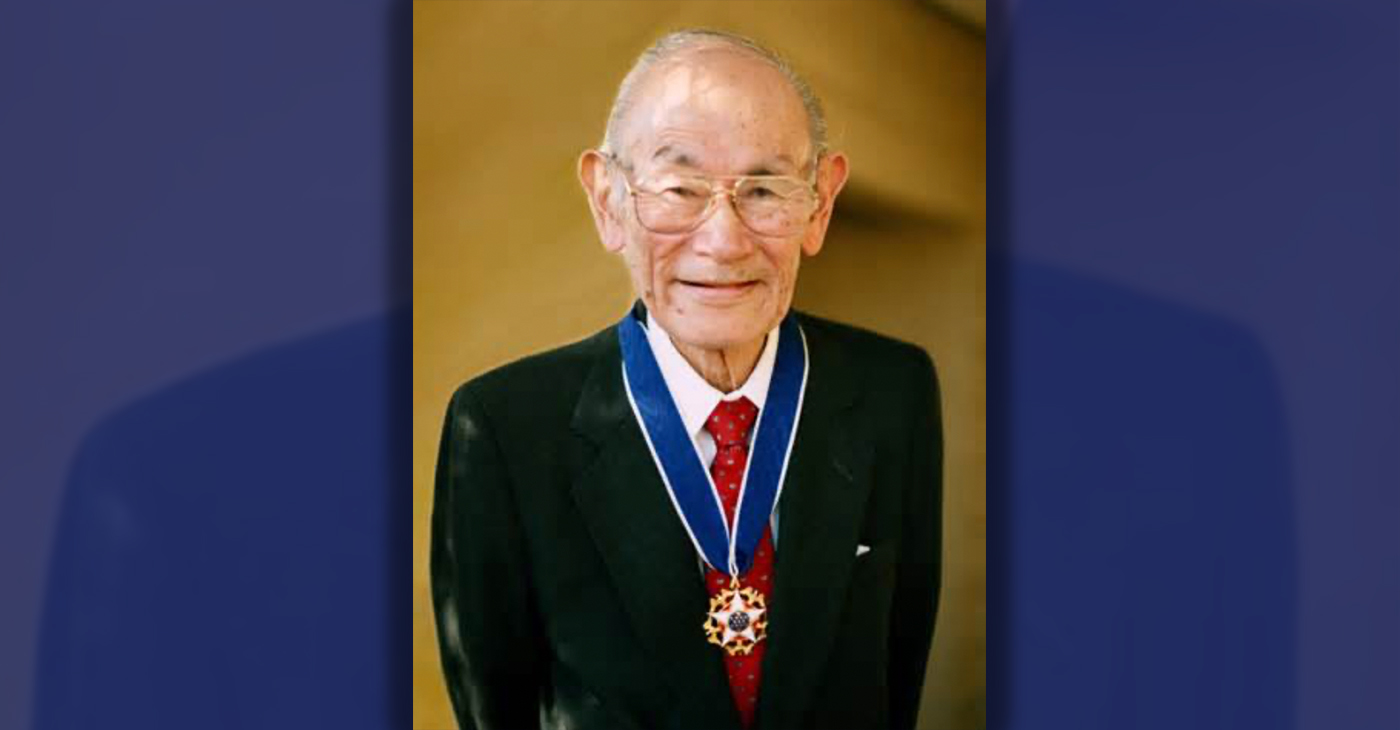
By Post Staff
Every Jan. 30, OUSD commemorates the legacy of Fred Korematsu, an Oakland native, a Castlemont High School graduate, and a national symbol of resistance, resilience, and justice.
His defiant stand against racial injustice and his unwavering commitment to civil rights continue to inspire the local community and the nation. Tuesday was “Fred Korematsu Day of Civil Liberties and the Constitution” in the state of California and a growing number of states across the country.
One OUSD school is named in his honor: Fred T. Korematsu Discovery Academy (KDA) elementary in East Oakland.
Several years ago, founding KDA Principal Charles Wilson, in a video interview with anti-hate organization “Not In Our Town,” said, “We chose the name Fred Korematsu because we really felt like the attributes that he showed in his work are things that the children need to learn … that common people can stand up and make differences in a large number of people’s lives.”
Fred Korematsu was born in Oakland on Jan. 30, 1919. His parents ran a floral nursery business, and his upbringing in Oakland shaped his worldview. His belief in the importance of standing up for your rights and the rights of others, regardless of race or background, was the foundation for his activism against racial prejudice and for the rights of Japanese Americans during World War II.
At the start of the war, Korematsu was turned away from enlisting in the National Guard and the Coast Guard because of his race. He trained as a welder, working at the docks in Oakland, but was fired after the bombing of Pearl Harbor in 1941. Fear and prejudice led to federal Executive Order 9066, which forced more than 120,000 Japanese Americans out of their homes and neighborhoods and into remote internment camps.
The 23-year-old Korematsu resisted the order. He underwent cosmetic surgery and assumed a false identity, choosing freedom over unjust imprisonment. His later arrest and conviction sparked a legal battle that would challenge the foundation of civil liberties in America.
Korematsu’s fight culminated in the Supreme Court’s initial ruling against him in 1944. He spent years in a Utah internment camp with his family, followed by time living in Salt Lake City where he was dogged by racism.
In 1976, President Gerald Ford overturned Executive Order 9066. Seven years later, the 9th Circuit Court of Appeals in San Francisco vacated Korematsu’s conviction. He said in court, “I would like to see the government admit that they were wrong and do something about it so this will never happen again to any American citizen of any race, creed, or color.”
Korematsu’s dedication and determination established him as a national icon of civil rights and social justice. He advocated for justice with Rosa Parks. In 1998, President Bill Clinton gave him the Presidential Medal of Freedom saying, “In the long history of our country’s constant search for justice, some names of ordinary citizens stand for millions of souls … To that distinguished list, today we add the name of Fred Korematsu.”
After Sept. 11, 2001, Korematsu spoke out against hatred and discrimination, saying what happened to Japanese Americans should not happen to people of Middle Eastern descent.
Korematsu’s roots in Oakland and his education in OUSD are a source of great pride for the city, according to the school district. His most famous quote, which is on the Korematsu elementary school mural, is as relevant now as ever, “If you have the feeling that something is wrong, don’t be afraid to speak up.”
Activism
WOMEN IMPACTING THE CHURCH AND COMMUNITY
Juanita Matthews, better known as “Sister Teacher,” is a walking Bible scholar. She moved to California from the great state of Arkansas in 1971. Sister Teacher has a passion for teaching. She has been a member of Bible Fellowship Missionary Baptist Church since 1971.
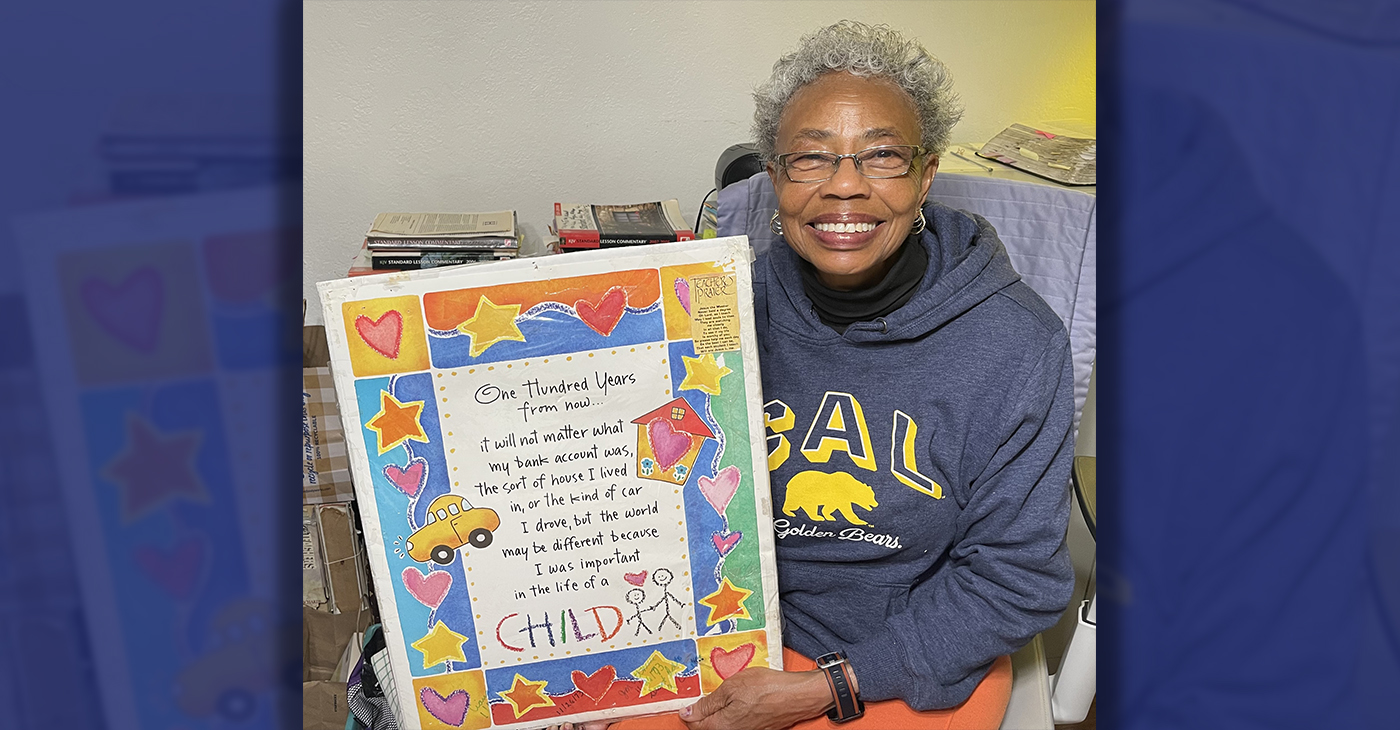
Sister Juanita Matthews
55 Years with Oakland Public School District
The Teacher, Mother, Community Outreach Champion, And Child of God
Juanita Matthews, better known as “Sister Teacher,” is a walking Bible scholar. She moved to California from the great state of Arkansas in 1971. Sister Teacher has a passion for teaching. She has been a member of Bible Fellowship Missionary Baptist Church since 1971. She followed her passion for teaching, and in 1977 became the lead teacher for Adult Class #6. Her motto still today is “Once My Student, Always My Student”.
Beyond her remarkable love for the Lord, Sister Teacher has showcased her love for teaching by working for the Oakland Unified School District for 55 years, all but four of those years spent at Emerson Elementary and Child Development School. She truly cares about her students, making sure they have the tools/supplies needed to learn either at OUSD or Bible Fellowship Missionary Baptist Church.
She’s also had a “Clothes Closet Ministry” for 51 years, making sure her students have sufficient clothing for school. The Clothes Closet Ministry extends past her students, she has been clothing the community for over 50 years as well. She loves the Lord and is a servant on a mission. She is a loving mother to two beautiful children, Sandra and Andre. This is the impact this woman of God has on her church and the community.
-

 Activism4 weeks ago
Activism4 weeks agoOakland Post: Week of March 20 – 26, 2024
-

 #NNPA BlackPress3 weeks ago
#NNPA BlackPress3 weeks agoCOMMENTARY: D.C. Crime Bill Fails to Address Root Causes of Violence and Incarceration
-

 #NNPA BlackPress3 weeks ago
#NNPA BlackPress3 weeks agoMayor, City Council President React to May 31 Closing of Birmingham-Southern College
-

 #NNPA BlackPress4 weeks ago
#NNPA BlackPress4 weeks agoFrom Raids to Revelations: The Dark Turn in Sean ‘Diddy’ Combs’ Saga
-

 #NNPA BlackPress4 weeks ago
#NNPA BlackPress4 weeks agoCOMMENTARY: Lady Day and The Lights!
-

 Activism3 weeks ago
Activism3 weeks agoOakland Post: Week of March 27 – April 2, 2024
-

 #NNPA BlackPress4 weeks ago
#NNPA BlackPress4 weeks agoBaltimore Key Bridge Catastrophe: A City’s Heartbreak and a Nation’s Alarm
-

 #NNPA BlackPress4 weeks ago
#NNPA BlackPress4 weeks agoBaltimore’s Key Bridge Struck by Ship, Collapses into Water



